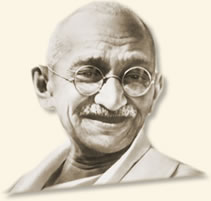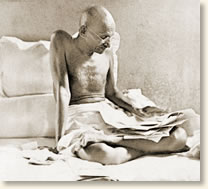The Assassination of Gandhi, 30 Jan 1948
HISTORY, 26 Jan 2015
Eyewitness to History – TRANSCEND Media Service
 “Just an old man in a loincloth in distant India: Yet when he died, humanity wept.” This was the observation of a newspaper correspondent at the death of Mahatma Gandhi. The tragedy occurred in New Delhi as the gaunt old man walked to a prayer-meeting and was engulfed by one of history’s great ironies – a life-long pacifist and promoter of non-violence struck down by an assassin’s bullet.
“Just an old man in a loincloth in distant India: Yet when he died, humanity wept.” This was the observation of a newspaper correspondent at the death of Mahatma Gandhi. The tragedy occurred in New Delhi as the gaunt old man walked to a prayer-meeting and was engulfed by one of history’s great ironies – a life-long pacifist and promoter of non-violence struck down by an assassin’s bullet.
Gandhi’s violent death came just months after the realization of his long sought-after goal – the independence of India from Great Britain. It was a bittersweet victory for Gandhi because along with India’s independence came the partitioning of the sub-continent into two separate states – Muslim-based Pakistan and Hindu-based India – an action he thoroughly opposed. Gandhi did not take part in the celebration of India’s independence.
Death of the Mahatma
Vincent Sheean was an American reporter and author who had covered trouble spots around the world in the years prior to and during World War II. In 1947, Sheean traveled to India and became a disciple of Gandhi in an attempt to find meaning in the violent and disruptive events he had witnessed during his years of reporting. We join his account as he rushes to join a prayer-meeting with Gandhi in the heart of New Delhi in the early evening hours of January 30, 1948:
“I got a taxi and went out to Birla House in time for the prayer-meeting. This time I was alone. I stationed my taxi under a tree opposite the gate of Birla House and walked down the drive to the prayer-ground. It was not yet five o’clock and people were still streaming in on foot, in cars and with tongas. As I came on to the prayer-ground at the end of the garden I ran into Bob Stimson, the Delhi correspondent of the B.B.C. We fell into talk and I told him about the journey to Amritsar and what had taken place there. It was unusual to see any representatives of the press at the prayer-meeting; Bob explained that he had submitted some questions to the Mahatma for the B.B.C. and thought he might as well stay for the prayers since he was on the premises. He looked at his watch and said: ‘Well, this is strange. Gandhi’s late. He’s practically never late.’
We both looked at our watches again. It was 5:12 by my watch when Bob said: ‘There he is.’ We stood near the corner of the wall, on the side of the garden where he was coming, and watched the evening light fall on his shining dark-brown head. He did not walk under the arbor this evening but across the grass, in the open lawn on the other side of the flower-beds. (There was the arbored walk, and a strip of lawn, and a long strip of flower-bed, and then the open lawn.)
 It was one of those shining Delhi evenings, not at all warm but alight with the promise of spring. I felt well and happy and grateful to be here. Bob and I stood idly talking, I do not remember about what, and watching the Mahatma advance toward us over the grass, leaning lightly on two of ‘the girls,’ with two or three other members of his ‘family’ (family or followers) behind them. I read afterward that he had sandals on his feet but I did not see them. To me it looked as if he walked barefoot on the grass. It was not a warm evening and he was wrapped in homespun shawls. He passed by us on the other side and turned to ascend the four or five brick steps which led to the terrace or prayer-ground.
It was one of those shining Delhi evenings, not at all warm but alight with the promise of spring. I felt well and happy and grateful to be here. Bob and I stood idly talking, I do not remember about what, and watching the Mahatma advance toward us over the grass, leaning lightly on two of ‘the girls,’ with two or three other members of his ‘family’ (family or followers) behind them. I read afterward that he had sandals on his feet but I did not see them. To me it looked as if he walked barefoot on the grass. It was not a warm evening and he was wrapped in homespun shawls. He passed by us on the other side and turned to ascend the four or five brick steps which led to the terrace or prayer-ground.
Here, as usual, there was a clump of people, some of whom were standing and some of whom had gone on their knees or bent low before him. Bob and I turned to watch – we were perhaps ten feet away from the steps-but the clump of people cut off our view of the Mahatma now; he was so small. Then I heard four small, dull, dark explosions. ‘What’s that?’ I said to Bob in sudden horror. ‘I don’t know,’ he said. I remember that he grew pale in an instant. ‘Not the Mahatma!’ I said, and then I knew.
Inside my own head there occurred a wavelike disturbance which I can only compare to a storm at sea – wind and wave surging tremendously back and forth. I remember all this distinctly; I do not believe that I lost consciousness even for a moment, although there may have been an instant or two of half-consciousness. I recoiled upon the brick wall and leaned against it, bent almost in two. I felt the consciousness of the Mahatma leave me then-I know of no other way of expressing this: he left me. …The storm inside my head continued for some little time-minutes, perhaps; I have no way of reckoning.
…lt was during this time, apparently, that many things happened: a whole external series of events took place in my immediate neighborhood – a few yards away – and I was unaware of them. A doctor was found; the police took charge; the body of the Mahatma was, carried away; the crowd melted, perhaps urged to do so by the police. I saw none of this. The last I saw of the Mahatma he was advancing over the grass in the evening light, approaching the steps. When I finally took my fingers out of my mouth and stood up, dry-eyed, there were police and soldiers and not many people, and there was Bob Stimson. He was rather breathless; he had gone somewhere to telephone to the B.B.C. He came with me down the steps to the lawn, where we walked up and down beside the flower-bed for a while. The room with the glass doors and windows, by the rose garden at the end of the arbor, had a crowd of people around it. Many were weeping. The police were endeavoring to make them leave. Bob could not tell me anything except that the Mahatma had been taken inside that room. On the following day he told me that he had seen him carried away and that the khadi which he wore was heavily stained with blood.”
References:
Vincent Sheean’s account appears in: Sheean, Vincent, Lead, Kindly Light (1949); Ashe, Geoffrey, Gandhi (1968).
Go to Original – eyewitnesstohistory.com
DISCLAIMER: The statements, views and opinions expressed in pieces republished here are solely those of the authors and do not necessarily represent those of TMS. In accordance with title 17 U.S.C. section 107, this material is distributed without profit to those who have expressed a prior interest in receiving the included information for research and educational purposes. TMS has no affiliation whatsoever with the originator of this article nor is TMS endorsed or sponsored by the originator. “GO TO ORIGINAL” links are provided as a convenience to our readers and allow for verification of authenticity. However, as originating pages are often updated by their originating host sites, the versions posted may not match the versions our readers view when clicking the “GO TO ORIGINAL” links. This site contains copyrighted material the use of which has not always been specifically authorized by the copyright owner. We are making such material available in our efforts to advance understanding of environmental, political, human rights, economic, democracy, scientific, and social justice issues, etc. We believe this constitutes a ‘fair use’ of any such copyrighted material as provided for in section 107 of the US Copyright Law. In accordance with Title 17 U.S.C. Section 107, the material on this site is distributed without profit to those who have expressed a prior interest in receiving the included information for research and educational purposes. For more information go to: http://www.law.cornell.edu/uscode/17/107.shtml. If you wish to use copyrighted material from this site for purposes of your own that go beyond ‘fair use’, you must obtain permission from the copyright owner.